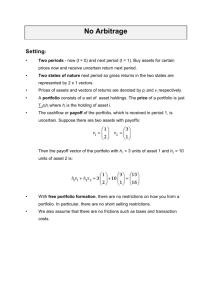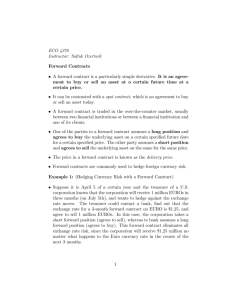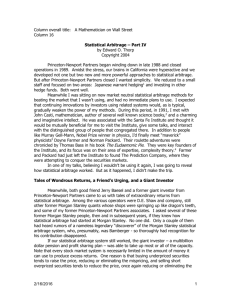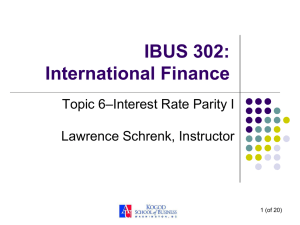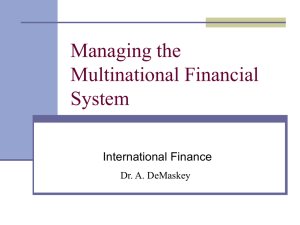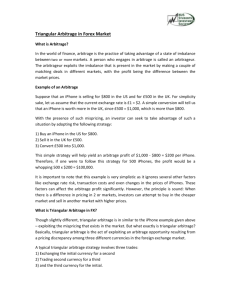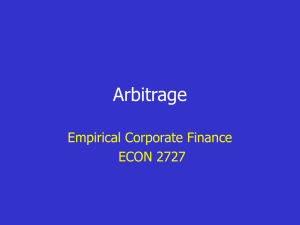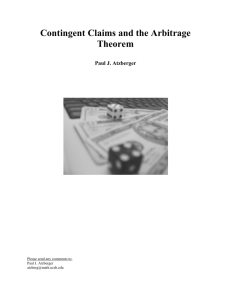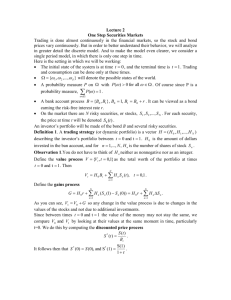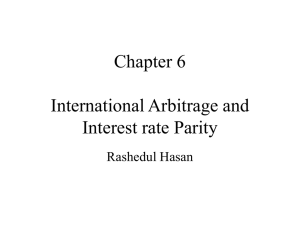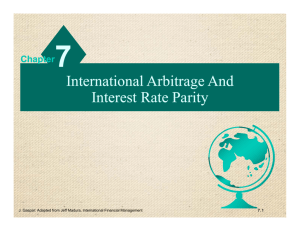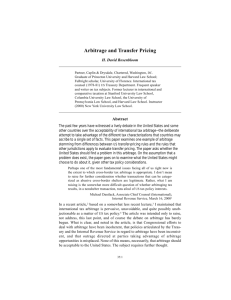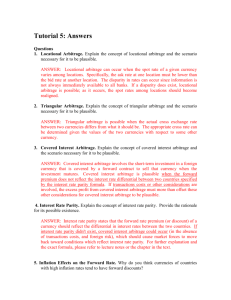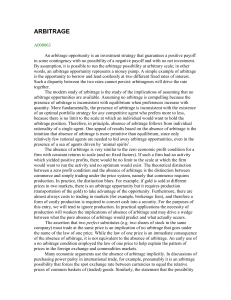Chapter 2
advertisement
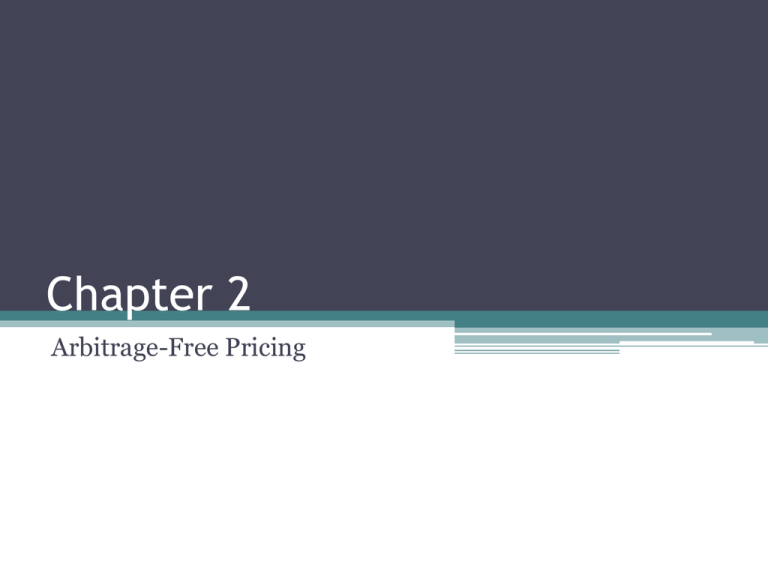
Chapter 2
Arbitrage-Free Pricing
Definition of Arbitrage
• Suppose we can invest in n assets.
Price of asset i at time t : 𝑃𝑖 𝑡
Units of asset I : 𝑥𝑖
Portfolio value : 𝑉 𝑡 =
𝑛
𝑖=1 𝑥𝑖 𝑃𝑖 (𝑡)
Definition of Arbitrage
• 𝑉 0 = 𝑛𝑖=1 𝑥𝑖 𝑃𝑖 (0) = 0
• 𝑃 𝑉 𝑇 ≥0 =1
• 𝑃 𝑉 𝑇 >0 >0
套利的定義,條件缺一不可
• Besides the definition given above, the principle of
no arbitrage has the following equivalent forms :
▫ We can not construct a riskless portfolio which returns more
than 𝑟𝑓
▫ If two portfolio have identical future cashflows with
certainty, then the two portfolio must have the same value at
the present time.
2.1 Example of Arbitrage
parallel yield curve shifts
• Suppose that
𝑃 0, 𝑇 = exp[−
𝑇
𝑓
0
0, 𝑢 𝑑𝑢]
• 𝑓 0, 𝑢 is the initial forward-rate curve at t=0
• Parallel shifts model dictates that at t=1 the forwardrate curve will be : 𝑓 1, 𝑇 = 𝑓 0, 𝑇 + 𝜖
2.1 Example of Arbitrage
parallel yield curve shifts
• At t=1
𝑇
𝑃 1, 𝑇 = exp −
𝑓 1, 𝑢 𝑑𝑢 = exp −
1
𝑇
= exp −
𝑇
1
𝑓 0, 𝑢 𝑑𝑢 −
0
𝑃(0, 𝑇) −(𝑇−1)𝜖
=
𝑒
𝑃(0,1)
(𝑓 0, 𝑢 + 𝜖)𝑑𝑢
1
𝑓 0, 𝑢 𝑑𝑢 − 𝑇 − 1 𝜖
0
此處的結果會在之後的投影片中用到
2.1 Example of Arbitrage
parallel yield curve shifts
• Let 𝑥𝑖 be the number of units held at t=0 of the bond
maturing at 𝑇𝑖 , i=1~3
• For an arbitrage we require
▫𝑉 0 =
▫𝑉 1 =
≥ 0,
> 0,
3
𝑖=1 𝑥𝑖 𝑃(0, 𝑇𝑖 )
3
𝑖=1 𝑥𝑖 𝑃(1, 𝑇𝑖 )
=0
𝑤𝑖𝑡ℎ 𝑝𝑟𝑜𝑏𝑎𝑏𝑖𝑙𝑖𝑡𝑦 1
𝑤𝑖𝑡ℎ 𝑝𝑟𝑜𝑏𝑎𝑏𝑖𝑙𝑖𝑡𝑦 𝑔𝑟𝑒𝑎𝑡𝑒𝑟 𝑡ℎ𝑎𝑛 0
2.1 Example of Arbitrage
parallel yield curve shifts
• The value of portfolio at t=1 is
• 𝑉1 𝜖 =
3
𝑖=1 𝑥𝑖 𝑃
1, 𝑇𝑖 =
𝑒 −𝜖 𝑇2 −1
𝑃 0,1
𝑔(𝜖)
此處乃應用稍早第5張投影片的結果而求得之結果,
•𝑔 𝜖 =
3
𝑖=1 𝑥𝑖 𝑃
0, 𝑇𝑖 𝑒 −𝜖(𝑇𝑖 −𝑇2)
至於把T2獨立出來的目的,則是為了方便之後的運算。
且由於V1(ε)中,左邊分數之分子分母皆大於零,表示V1(ε)的正負、
大小僅與g(ε)有關
2.1 Example of Arbitrage
parallel yield curve shifts
• 𝑔 𝜖 =
3
𝑖=1 𝑥𝑖 𝑃
0, 𝑇𝑖 𝑒 −𝜖(𝑇𝑖 −𝑇2 )
• For an arbitrage , we require that 𝑉1 𝜖 > 0 for all 𝜖 ≠ 0, and
since 3𝑖=1 𝑥𝑖 𝑃(0, 𝑇𝑖 ) = 0
𝑔 0 =0
we must have first order condition
𝑔′ 0 = 0
3
𝑥𝑖 (𝑇2 − 𝑇𝑖 )𝑃(0, 𝑇𝑖 ) = 0
𝑖=1
3
𝑥𝑖 𝑇𝑖 𝑃(0, 𝑇𝑖 ) = 0
𝑖=1
因為g(0)=0, 𝑉1 0 = 0
又𝑉1 𝜖 > 0,所以𝜖=0必定為
g(𝜖)的最低點。
2.1 Example of Arbitrage
parallel yield curve shifts
• And S.O.C
3
𝑔′′ 𝜖 =
𝑔′′ (0) ≥ 0
𝑥𝑖 (𝑇2 − 𝑇𝑖 )2 𝑃(0, 𝑇𝑖 )𝑒 −𝜖(𝑇𝑖 −𝑇2)
𝑖=1
Example 2.1
• Suppose that 𝑃 0, 𝑡 = 𝑒 −0.08𝑡 for all t > 0, and that,
for all t > 0,
𝑒 −0.1𝑡
𝑖𝑓 𝐼 = 1
𝑃 1, 𝑡 + 1 = −0.06𝑡
𝑒
𝑖𝑓 𝐼 = 0
where I= 0 or 1 is a random variable. In other words,
the spot- and forward-rate curves will both have a
shift up or down of 2%.
Example 2.1
Suppose that we hold 𝑥1 , 𝑥2 and 𝑥3 units of the bonds
maturing at times 1, 2 and 3 respectively, such that
𝑥2 𝑃 0,2 = −1
𝑥1 𝑃 0,1 + 𝑥2 𝑃 0,2 + 𝑥3 𝑃 0,3 = 0
𝑥1 𝑃 0,1 + 2𝑥2 𝑃 0,2 + 3𝑥3 𝑃 0,3 = 0
運用到的條件:
1. 假定𝑥2 𝑃 0,2 = −1
2. 3𝑖=1 𝑥𝑖 𝑃(0, 𝑇𝑖 ) = 0
3. F.O.C.
3
𝑥𝑖 𝑇𝑖 𝑃(0, 𝑇𝑖 ) = 0
𝑖=1
Example 2.1
1
𝑥1 =
= 0.541644
2𝑃(0,1)
−1
𝑥2 =
= −1.173511
𝑃(0,2)
1
𝑥3 =
= 0.635624
2𝑃(0,3)
• At time 1 the value of this portfolio is 0.00021 if I=1
or 0.00022 if I=0.
2.2 Fundamental Theorem of Asset Pricing
• Suppose risk-free rate r(t) is stochastic.
Randomness in r(t) is underpinned by the
probability triple Ω, ℱ, 𝑃 , P is the real world
probability measure.
• Let cash account be
𝑡
𝐵 𝑡 = 𝐵 0 exp(
𝑟 𝑠 𝑑𝑠)
0
𝑑𝐵 𝑡 = 𝑟 𝑡 𝐵 𝑡 𝑑𝑡
2.2 Fundamental Theorem of Asset Pricing
• Theorem 2.2
1. Bond price evolve in a way that is arbitrage free if
and only if there exists a measure Q, equivalent to P,
under which, for each T, the discounted price process
P(t,T)/B(t) is a martingale for all t: 0<t<T
2. If 1. holds, then the market is complete if and only if
Q is the unique measure under which the P(t ,T)/B(t)
are martingales.
The measure Q is often referred to, consequently, as the
equivalent martingale measure.
2.2 Fundamental Theorem of Asset Pricing
• Value of zero coupon bond at time t :
𝑇
𝑃 𝑡, 𝑇 = 𝐸𝑄 exp − 𝑡 𝑟 𝑠 𝑑𝑠 ℱ𝑡
(since P(T,T)=1)
• If X is some ℱt -measurable derivative payment
payable at T, V(t) is the fair value of this derivative
contract
𝑇
𝑉 𝑡 = 𝐸𝑄 exp − 𝑡 𝑟 𝑠 𝑑𝑠 𝑋 ℱ𝑡
Example 2.5 forward pricing
• A forward contract has been arranged in which a
price K will be paid at time T in return for a
repayment of 1 at time S (T<S). Equivalently, K is
paid at T in return for delivery at the same time T of
the S-bond which has a value at that time of P(T,S).
How much is this contract worth at time t<T ?
Example 2.5 forward pricing
• As an interest rate derivative contract, this has value 𝑋 =
𝑃 𝑇, 𝑆 − 𝐾 at time t.
• 𝑉 𝑡 = 𝐸𝑄 exp −
= 𝐸𝑄 exp −
=
𝑇
𝑟
𝑡
𝑇
𝑟
𝑡
𝑢 𝑑𝑢 𝑋 ℱ𝑡
𝑢 𝑑𝑢 (𝑃 𝑇, 𝑆 − 𝐾) ℱ𝑡
=
−
𝑆
𝐸𝑄 exp − 𝑡 𝑟 𝑢 𝑑𝑢
𝑇
K𝐸𝑄 exp − 𝑡 𝑟 𝑢 𝑑𝑢
ℱ𝑡
ℱ𝑡
= 𝑃 𝑡, 𝑆 − 𝐾𝑃 𝑡, 𝑇
• If we choose K to ensure that V(t)=0, then
𝑃(𝑡, 𝑆)
𝐾=
𝑃(𝑡, 𝑇)
where
2.6 Put-Call Parity
• Consider European call and put options with the same
exercise date T, a strike price K, and the underlying Sbond, P(t,S), S>T
• Time=t
𝑜𝑛𝑒 𝑐𝑎𝑙𝑙 𝑜𝑝𝑡𝑖𝑜𝑛 𝑝𝑙𝑢𝑠 𝐾 𝑢𝑛𝑖𝑡𝑠 𝑜𝑓 𝑇𝑏𝑜𝑛𝑑, 𝑃(𝑡, 𝑇)
𝑜𝑛𝑒 𝑝𝑢𝑡 𝑜𝑝𝑡𝑖𝑜𝑛 𝑝𝑙𝑢𝑠 𝑜𝑛𝑒 𝑢𝑛𝑖𝑡 𝑜𝑓 𝑡ℎ𝑒 𝑆𝑏𝑜𝑛𝑑, 𝑃(𝑡, 𝑇)
• Time=T
max 𝑃 𝑇, 𝑆 − 𝐾, 0 + 𝐾 = max{𝑃 𝑇, 𝑆 , 𝐾}
max 𝐾 − 𝑃 𝑇, 𝑆 , 0 + 𝑃 𝑇, 𝑆 = max{𝑃 𝑇, 𝑆 , 𝐾}
2.6 Put-Call Parity
• By the law of one price, the values of the two
portfolio at any earlier time must also be equal
𝑐 𝑡 + 𝐾𝑃 𝑡, 𝑇 = 𝑝 𝑡 + 𝑃(𝑡, 𝑆)


